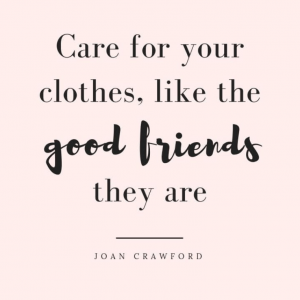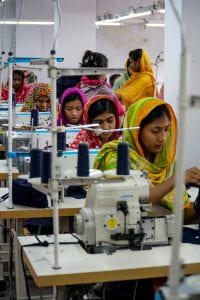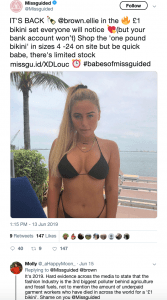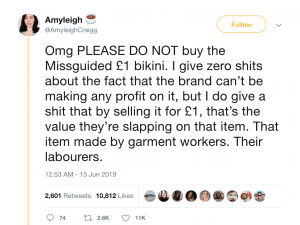
Last week, I wrote about easy ways you can start thinking and dressing more ethically and sustainably. This week, I’ll define and clarify the differences between Ethical Fashion and Sustainable Fashion. I will also shine a spotlight on Austin-based Esby Apparel. This chic, niche fashion brand uses both ethical and sustainable practices. Read on to learn how Esby is doing things differently and setting the bar higher for other brands.
Ethical Fashion vs. Sustainable Fashion
I’ve used these phrases a number of times in previous posts, but before I use them to talk about Esby, I want to take a moment to define Ethical Fashion and Sustainable Fashion. They aren’t the same and the terms aren’t interchangeable, but they do frequently overlap. This is why you’ll often see “ethical and sustainable” paired together. So, how are they different, and how do they work together? I’ll also explain how “Slow Fashion” fits into the picture. Let’s examine.
◊ Ethical Fashion
According to the world’s leading museum of art and design, The Victoria & Albert Museum,
Ethical Fashion aims to address the problems it sees with the way the fashion industry currently operates, such as exploitative labour [sic], environmental damage, the use of hazardous chemicals, waste, and animal cruelty. (VAM, 2013)
An umbrella term, ethical fashion looks at all stages of “design, production, retail, and purchasing” (VAM, 2013). An ethical brand will “make an effort to provide detailed information about how their processes meet moral benchmarks” (Kenton, 2019).
You can read my post about ethical fashion practices here for more background on some of the concepts below.
Ethical Fashion concepts include:
- Supply Chain Transparency
- Fair Trade, defined as fashion “created with a goal of empowering marginalised [sic] people while paying them a fair wage and ensuring fair working conditions” (Meier, 2017).
- Cruelty-Free (such as fur-free or not tested on animals)
- Human Rights
- Conscious Consumerism
- Inclusive Fashion (size, ability, gender identity)
- Sustainable Fashion (yep–sustainable fashion falls under Ethical Fashion!)
◊ Sustainable Fashion
Sustainable fashion is a movement and process of fostering change to fashion products and the fashion system towards greater ecological integrity and social justice. Sustainable fashion concerns more than addressing fashion textiles or products. It comprises addressing the whole system of fashion. This means dealing with interdependent social, cultural, ecological and financial systems. It also means considering fashion from the perspective of many stakeholders – users and producers, all living species, contemporary and future dwellers on earth. Sustainable fashion, therefore, belongs to, and is the responsibility of citizens, public sector and private sector. (Sustainable Fashion, 2019)
Sustainable Fashion (aka Eco-Fashion) concepts include:
- Products “made to environmentally-friendly standards” (Meier, 2017)
- Eco-fibers: linen, organic cotton; upcycled, recycled, or reclaimed fabrics
- Depending on processing methods, new fabrics like bamboo and hemp
- Sometimes, Fair Trade Fashion is “considered sustainable fashion as the production is considered ‘sustainable’ to communities of farmers and artisans in providing livelihoods and investing in eco-projects” (Meier, 2017).
-
- In this view, Supporting/Shopping locally-owned businesses can be considered a sustainable practice
-
- Fashion industry’s environmental footprint, including:
-
- Pollution (including air, water, sound)
- Excessive waste (from manufacturing practices and consumers’ belief that cheap, fast fashion is “disposable”)
- Carbon emissions and contribution to climate change
- Loss of biodiversity
-
◊ Slow Fashion
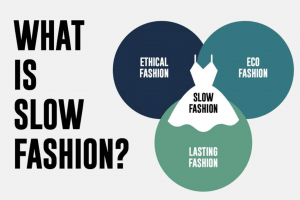
Slow Fashion is a lifestyle choice (part of the Slow Living Movement) that combines concepts from both ethical and sustainable fashion. In Slow Fashion, the ethical connection between things is examined: raw materials, human labor, the environment, and more (Kowalski, 2018). It is purposeful and intentional, and about quality over quantity; garments can last years or even a lifetime. The concept is holistic and considers the whole product lifecycle. Designer Emilia Wick thinks of Slow Fashion as “returning to a personal relationship with fashion,” and author Kate Fletcher says it’s about “designing, producing, consuming and living better” (Kowalski, 2018).
Fletcher, who is widely credited with coining the term in 2007 (Kowalski, 2018), defines Slow Fashion as:
- “Not time-based but quality-based“
- A new and different “approach in which designers, buyers, retailers and consumers are more aware of the impacts of products on workers, communities and ecosystems“
- About “choice, information, cultural diversity and identity”
- A method that requires “durability and long-term engaging, quality products”
Now that you know what these terms mean and how they can overlap, let’s talk about a brand that practices Ethical, Sustainable, and Slow Fashion.
Brand Spotlight: Esby Apparel
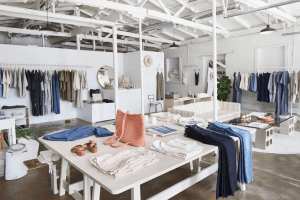
If you talked to me about ethical and sustainable fashion in person, it’s very likely that I’d bring up my favorite slow fashion brand, Esby. With good reason: Esby founder and designer Stephanie Beard was fairly instrumental in sparking my interest in ethical fashion. I met Stephanie about 6 years ago through a close mutual friend of ours (see our group pic at the bottom! 💗), just as she was beginning to build the Esby brand.
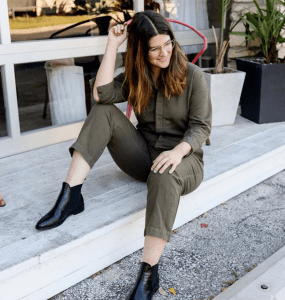
A little backstory on me–I am passionate about entrepreneurship, it was my major in undergrad. I’m especially interested in female entrepreneurs; I’ve always loved hearing about the children’s clothing shop my grandmother owned in the ‘60s and ‘70s, and before grad school, I worked for female entrepreneurs for about a dozen years. Combine that backstory and my love of fashion and you’ll see why I am constantly impressed by this smart, ambitious lady who came to town, said she was going to start a fashion line, and actually did it. Not only that, but Stephanie made Esby a successful brand that has captured the attention of some impressive publications like Business of Fashion, Forbes, Elle, Austin Monthly, domino, WHO WHAT WEAR, and more.

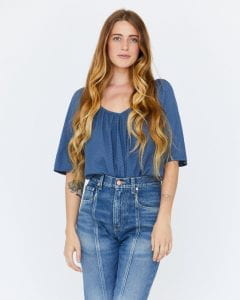
While I don’t get to see Stephanie frequently, I’ve watched, mostly by following Stephanie and Esby on Instagram and by being on the Esby email list, as she has built this brand. Along the way, I learned bits and pieces about ethical and sustainable fashion, as Stephanie was meticulous about doing things the right way from the beginning.
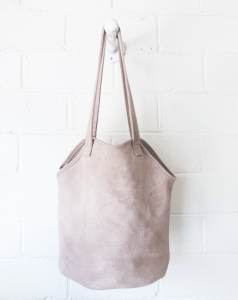
For example, I remember catching up with her one time as she was searching for a place in the U.S. that would sew the tags on Esby clothing. That’s when I learned that many brands send their clothes overseas for tagging, even if the clothes are made in the U.S., adding to the clothing’s eco-footprint. Also, I didn’t know that entire garments are rarely made under one roof; the entire manufacturing process frequently requires shipping items many thousands of miles, multiple times, until they are completed and finally end up in a store. It’s certainly not a sustainable practice, so it’s incredibly important that brands like Esby are making major changes to the way fashion is produced. This is just one aspect of sustainable apparel production I learned about while watching this brand unfold; I could go on, but the point is that Stephanie and Esby really got me into the concept of ethical, sustainable fashion.
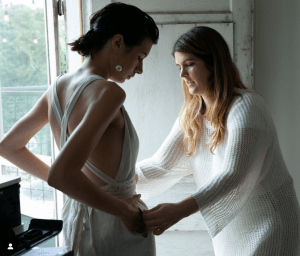
About the Brand
Founder and designer Stephanie Beard launched Esby Apparel in 2014 in Austin, Texas. With over a decade of experience in kids and menswear design and a minimalist POV from years of NYC-living, Stephanie lent a unique perspective to women’s fashion with a menswear mentality. Esby has grown so much that the line now includes select men’s, plus size, and unisex styles–so inclusive!
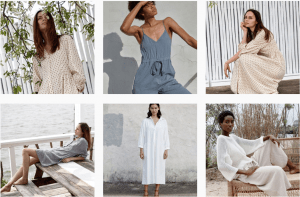
Focusing on simplistic design and the highest quality fabrics, Esby is sourced globally and produced in the U.S. Collections are destination-inspired and include classic silhouettes with a vintage influence and comfortable wearability. Every item is pre-washed and pre-shrunk for a true fit, their website features detailed product measurements for each item, and the website even provides a way to reach out for fit advice. Esby uses ethical and sustainable practices and promotes slow fashion.

Doing Things Differently: Details of Esby’s Ethical & Sustainable Practices
Fabrics are made of the highest quality all-natural fibers carefully sourced from around the world, including Japanese textiles, French linens, Italian yarns, and Texas organic cotton. Esby works closely with factory partners throughout the patterning process, using small-batch production methods to reduce material waste. Any fabric leftover gets repurposed in Esby’s No-Waste initiative, in which best-selling Esby styles are reproduced from remnant fabrics in a limited run. In addition, the brand recently did its first buy-back event in which customers could sell gently-used Esby clothes from previous seasons back to the brand. This sustainable, eco-friendly practice is one that many brands are adopting, keeping clothes out of the landfill and the used, repurposed or upcycled items circulate in the economy longer (Segran, 2019).
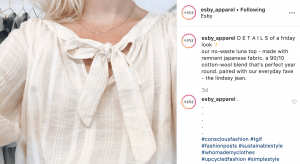
Esby uses low-impact garment dyes in a Los Angeles-based dye house that runs on solar energy. All fabrics are pre-washed for softness and pre-shrunk for a true fit.
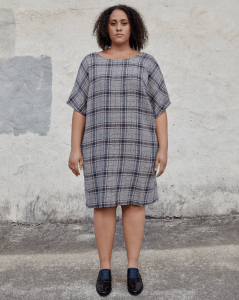
Esby Apparel is designed in Austin, Texas, and produced locally in the U.S., specifically in small factories with positive working environments in New York and Los Angeles. Esby vets new potential factories thoroughly, and conducts regular in-person walk-throughs on factory floors. Most brands do not practice this level of due diligence and instead use unreliable outside reporting and factory inspections. Basing all production in the U.S. means Esby has closer and more frequent oversight opportunities to ensure the conditions are being upheld. In addition, producing locally means more government oversight and regulation than producing in another country, on another continent.
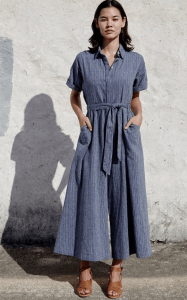
I can tell you from experience, the fit is on point, the clothes are comfortable, and there’s nothing I’d rather wear in the Texas heat. Everything is versatile, well-constructed, and meant to be worn on repeat for years. And a bonus, it’s all machine washable and dryable! This post is not sponsored, I’m just an advocate for any brand that’s this considerate of their impact on the world and has great style. Pro tip: sign up for Esby’s email list to find out about new arrivals and sales first. Keep an eye out for the very reasonable sample sales!
Shopping with Esby Apparel is a win-win situation. You’ll support an Austin- and female-owned business, the creation of local jobs, and of course–ethical and sustainable fashion. It doesn’t get better than that! If you have any questions about Esby and their practices, I’d be happy to ask and pass answers along.
Esby Apparel
1601 South 1st Street, Austin, TX
512-243-8901
info@esbyapparel.com
https://www.esbyapparel.com/
Esby Stockists
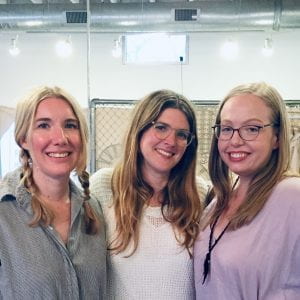
As always, thank you for visiting and reading!
Stylishly Yours,
Molly
References:



